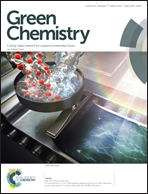Selective recovery of rare earth elements from ion-adsorption rare earth element ores by stepwise extraction with HEH(EHP) and HDEHP
Abstract
Ion-adsorption rare earth element (REE) ores are strategic mineral resources, particularly for heavy REEs. To reduce the amount of nitrogen in the form of ammonia in waste waters and to increase the low recovery efficiency of the current extraction process for REEs, we developed a novel environmentally friendly stepwise solvent extraction method for the separation and enrichment of REEs. Based on their different extraction abilities and a cation-exchange mechanism, two acidic phosphorus extractants (HEH(EHP) and HDEHP) were selected to sequentially separate and enrich REEs. Using this novel technique, ammonia nitrogen emissions were completely avoided and the recovery efficiency of REEs was significantly improved. From the McCabe–Thiele plots, it was found that a three-stage HEH(EHP) extraction at VA/VO = 10/1 and two-stage HCl stripping at VA/VO = 1/16 were required to enrich heavy REEs, whereas a three-stage HDEHP extraction at VA/VO = 25/1 and three-stage HCl stripping at VA/VO = 1/20 were required to enrich light REEs. The total recovery efficiency realized for REEs was >99% and the heavy and light REE chloride concentrations in solution were up to 240 and 200 g L−1, respectively. These results suggest an efficient way of recovering REEs from a leaching solution with low concentrations.


 Please wait while we load your content...
Please wait while we load your content...